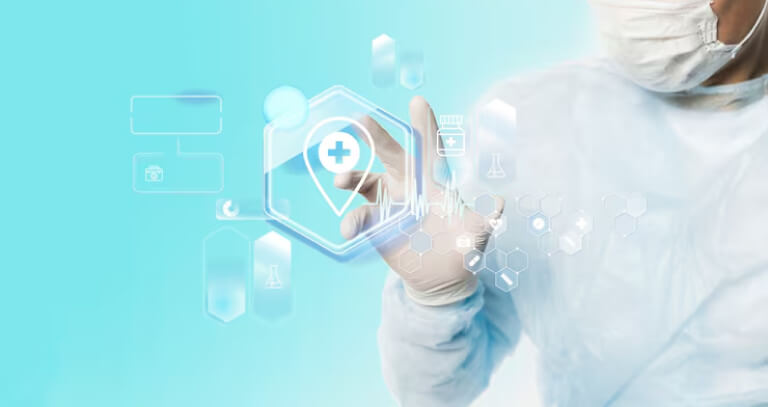Computer Vision in Healthcare: Exploring Use Cases, Advantages, and Future Potential
Ditstek Blogs
The healthcare industry is undergoing a paradigm shift with the integration of artificial intelligence (AI) and computer vision. Medical imaging, diagnostics, robotic surgeries, and patient monitoring are no longer reliant solely on human expertise. AI-powered computer vision is enhancing precision, improving efficiency, and accelerating decision-making, making it an indispensable tool in modern medicine.
With millions of medical images generated daily, radiologists and physicians face an overwhelming task of analyzing data efficiently. Computer vision algorithms can detect patterns, identify anomalies, and assist in diagnoses with accuracy levels surpassing human capability. From detecting early-stage cancers in radiology scans to guiding robotic-assisted surgeries with real-time imaging, this technology is transforming healthcare delivery.
But how does computer vision actually work in healthcare? What are its real-world applications? And more importantly, how is it reshaping the future of medicine?
In this blog, we’ll dive deep into the world of computer vision in healthcare—exploring its core techniques, adoption areas, game-changing applications, and the immense benefits it offers.
What is Computer Vision in Healthcare?
Computer vision is a branch of artificial intelligence (AI) that enables machines to interpret, analyze, and understand visual data, much like the human eye—but with exponentially greater speed and precision. At its core, computer vision in healthcare revolves around processing medical imagery—X-rays, MRIs, CT scans, histopathology slides, and even real-time video feeds from operating rooms or patient monitoring systems. Using deep learning models and advanced algorithms, these systems can identify abnormalities, detect patterns, segment organs or tissues, and assist healthcare professionals in decision-making.
Unlike traditional imaging techniques that require manual interpretation by radiologists and clinicians, AI-driven computer vision automates the detection process, reduces human error, and enhances diagnostic efficiency. Hospitals and medical institutions are increasingly adopting this technology to accelerate workflows, improve patient outcomes, and enhance medical research.
Computer Vision in Healthcare Market

The computer vision in healthcare market is experiencing rapid growth, driven by increasing demand for AI-powered diagnostics, robotic surgeries, and automated patient monitoring. Valued at over $3 billion in 2023, it is projected to exceed $10 billion by 2030, fueled by advancements in deep learning and medical imaging. Leading players include Google DeepMind, Qure.ai, and Aidoc, alongside innovative startups disrupting AI-driven healthcare. Investments are surging, with major funding in AI-based radiology and drug discovery. However, challenges like data privacy, regulatory approvals, and adoption costs persist, creating both barriers and opportunities for the market’s expansion.
Also Read: Business Intelligence in Healthcare Industry
Essential Techniques Behind Computer Vision in Healthcare

Below are the essential techniques that form the backbone of computer vision in healthcare.
Deep Learning
Deep learning is the driving force behind modern computer vision applications. It involves multi-layered neural networks, particularly Convolutional Neural Networks (CNNs), which are designed to recognize patterns in images. These models learn from vast datasets of medical scans to differentiate between normal and abnormal tissue structures, detect tumors, and classify diseases with high precision.
Example: AI-driven radiology tools use CNNs to detect lung abnormalities, fractures, and tumors in X-rays and CT scans.
Image Recognition
Image recognition enables AI to identify and classify visual objects within medical images. By training on labeled datasets, AI can recognize specific anatomical structures, abnormal growths, or disease markers.
Example: AI-powered dermatology applications recognize skin lesions and classify them as benign or malignant, aiding in early skin cancer detection.
Also Read: How Much Does Facial Recognition Software Cost
Object Detection
Object detection extends beyond classification by locating and labeling specific regions in an image. It allows AI models to highlight abnormalities such as tumors, fractures, or vascular blockages.
Example: In cardiology, AI detects blockages in coronary arteries using angiographic images, aiding in heart disease diagnosis.
Segmentation
Image segmentation divides a medical image into meaningful sections, isolating organs, tissues, tumors, or blood vessels. This technique is crucial for measuring growth patterns and assessing disease progression.
Example: In oncology, segmentation helps doctors visualize tumor boundaries in MRI scans, aiding in radiation therapy planning.
Pattern Recognition
Pattern recognition enables AI to identify recurring features in medical images, which is crucial for disease detection. It helps in detecting subtle changes that might be overlooked by human eyes.
Example: AI systems in pathology detect cancerous cell patterns in histopathology slides, accelerating the diagnostic process.
Feature Extraction
Feature extraction involves selecting the most relevant parts of an image that contribute to a diagnosis. Instead of analyzing the entire image, AI focuses on specific shapes, textures, edges, and intensity levels.
Example: In ophthalmology, feature extraction helps detect retinal diseases like diabetic retinopathy by analyzing eye scan images.
Edge Detection
Edge detection is a technique that helps in identifying the boundaries of structures in an image. It enhances the visibility of tumors, lesions, and anatomical features, making them easier to analyze.
Example: AI-assisted stroke detection systems use edge detection to highlight affected brain regions in MRI scans, enabling faster intervention.
3D Vision
3D vision extends traditional imaging techniques by reconstructing three-dimensional models of anatomical structures. This is especially useful in surgical planning and robotic-assisted procedures.
Example: In orthopedics, 3D vision helps surgeons create precise models of bones and joints before performing reconstructive surgery.
Computer Vision Adoption Areas in Healthcare

Computer vision is not confined to a single area of medicine—it is making an impact across multiple specialties, enhancing diagnostic accuracy, surgical precision, and patient monitoring. From radiology to telehealth, AI-driven vision systems are transforming how healthcare professionals interpret medical images, detect diseases, and provide treatments. Below are the key areas where computer vision is being adopted in healthcare.
1. Computer Vision in Telehealth
Telehealth has fundamentally transformed healthcare delivery, making medical consultations more accessible and convenient. However, one of the biggest challenges in remote healthcare is accurate patient assessment—especially when it comes to observing physical signs, body movements, and facial expressions. Traditional video consultations lack depth, often leaving healthcare professionals with limited ways to gauge a patient’s condition beyond verbal descriptions.
This is where computer vision is revolutionizing telehealth.
What is Computer Vision in Telehealth?
In telehealth, computer vision tools analyze live video feeds to track and assess body movements, facial expressions, and hand gestures. By integrating real-time AI-powered visual analysis into telehealth consultations, this technology enhances remote patient monitoring, diagnostics, and engagement tracking, ultimately leading to more precise assessments and better-informed medical decisions.
Real-Time Insights for Better Decision-Making
One of the most transformative applications of computer vision in telehealth is real-time feedback during virtual consultations. While a healthcare provider observes a patient via video, AI-driven computer vision algorithms overlay important visual data, flagging potential concerns such as:
- Unusual postures or awkward movements – Indicators of joint pain, neuromuscular disorders, or early-stage Parkinson’s disease.
- Subtle facial expressions – Detection of discomfort, depression, or neurological impairments.
- Irregular body movements – Signs of motor function disorders, stroke aftermath, or muscle atrophy.
For instance, if a patient struggles to explain symptoms of joint stiffness, the system can detect restricted movements or uneven gait patterns through AI-powered body tracking—providing valuable diagnostic insights, even when the patient isn’t able to articulate them fully.
The Technology Behind Telehealth’s Computer Vision Revolution
At the forefront of real-time AI-powered patient assessment is Mediapipe, an advanced computer vision framework developed by Google. Mediapipe Holistic Model combines cutting-edge machine learning and visual tracking algorithms to analyze:
- Body movements – Helps identify mobility issues, neuromuscular disorders, and musculoskeletal abnormalities.
- Facial expressions – Detects emotional distress, cognitive impairments, and early signs of depression.
- Hand gestures – Assists in neurology-related assessments, including tremors in Parkinson’s disease patients.
Why Does It Matter?
The demand for AI-powered custom healthcare solutions is rapidly increasing, and computer vision is emerging as a key enabler of next-generation telehealth. This technology not only enhances clinical decision-making but also ensures that patients receive timely and accurate care, even when they cannot visit a healthcare facility in person.
2. Computer Vision in Radiology
Radiology is the backbone of modern diagnostics, providing X-rays, CT scans, MRIs, and ultrasounds that help doctors detect and monitor diseases. However, the growing volume of medical imaging data is overwhelming radiologists, leading to delayed diagnoses, misinterpretations, and increased workload stress. Traditional manual interpretation of scans can be time-consuming and prone to errors, especially in complex cases where subtle abnormalities may be difficult to detect.
This is where computer vision is transforming radiology. AI-driven image analysis can enhance diagnostic accuracy, automate routine screenings, and assist radiologists in detecting life-threatening conditions faster than ever before.
How Computer Vision is Enhancing Radiology
Computer vision in radiology uses deep learning algorithms to analyze millions of medical images, learning patterns that indicate diseases. These models can highlight anomalies, classify findings, and even predict disease progression. AI-powered tools reduce the burden on radiologists, allowing them to focus on complex cases rather than spending hours reviewing routine scans.
- Early Disease Detection: AI-driven radiology tools can detect tumors, fractures, and lung abnormalities in scans with high precision.
- Faster Diagnoses: Automated image analysis speeds up scan interpretation, reducing patient wait times.
- Enhanced Accuracy: AI reduces the risk of human error, improving diagnostic confidence.
Leading Technologies in AI Radiology
Several AI-powered radiology platforms are leading the revolution in automated diagnostics:
- Google DeepMind’s AI – Breast cancer detection in mammograms.
- Zebra Medical Vision – AI-driven diagnosis of chest X-rays and CT scans.
- Qure.ai – Automated detection of lung diseases and stroke.
- Viz.ai – Real-time stroke detection and brain imaging analysis.
- BoneView – AI-powered orthopedic imaging solutions.
3. Computer Vision in Orthopedics
Orthopedics is a highly imaging-dependent field, where accurate diagnosis and treatment planning rely on X-rays, CT scans, MRIs, and 3D imaging. Detecting fractures, joint degeneration, and musculoskeletal disorders can be challenging, especially in subtle or early-stage cases. Misinterpretations or delays in diagnosis can lead to chronic pain, mobility loss, or even permanent disability.
This is where computer vision is revolutionizing orthopedic imaging. AI-driven image analysis enhances fracture detection, joint assessments, and surgical planning, ensuring faster diagnoses and more precise treatments.
How Computer Vision is Transforming Orthopedics
Computer vision in orthopedics applies deep learning algorithms to analyze bone structures, detect abnormalities, and assist in surgical navigation. These AI models can automate fracture detection, track disease progression, and improve surgical precision by offering real-time insights and 3D modeling.
Leading AI Technologies in Orthopedic Imaging
Several AI-driven platforms are revolutionizing orthopedic diagnostics and treatment planning:
- BoneView AI – AI-assisted fracture detection in X-rays and CT scans.
- OrthoAI – AI-powered 3D reconstruction for personalized joint replacements.
- SpineAI – AI-driven spinal disorder detection and surgical planning.
- OsteoVision – AI-based cartilage analysis for osteoarthritis monitoring.
4. Computer Vision in Cardiology
Cardiovascular diseases (CVDs) remain the leading cause of death worldwide, with conditions like heart attacks, strokes, and arrhythmias often going undetected until it's too late. Traditional diagnostic methods—such as echocardiograms, angiograms, and ECGs—require manual interpretation, which can be time-consuming and prone to variability between specialists. Early detection and precise diagnosis are critical to saving lives, but physician workloads and imaging complexity pose significant challenges.
This is where computer vision is transforming cardiology. AI-powered imaging tools analyze heart scans, detect abnormalities, assess risks, and predict cardiac conditions with unparalleled speed and accuracy. From detecting blockages in arteries to predicting heart failure, computer vision is redefining cardiovascular care.
How Computer Vision is Enhancing Cardiology
AI-driven computer vision models process thousands of cardiovascular images to identify subtle abnormalities that might be missed by the human eye. These algorithms help cardiologists assess heart health faster, monitor disease progression, and enhance treatment planning.
Leading AI Technologies in Cardiology
Several AI-powered cardiology platforms are enhancing diagnostic accuracy and efficiency:
- HeartFlow AI – 3D visualization of coronary artery disease for interventional planning.
- Viz.ai – AI-based stroke detection in CT scans for rapid emergency response.
- Ultromics – AI-powered echocardiogram analysis for heart failure detection.
- Cardiologs – AI-driven ECG interpretation for arrhythmia detection.
- AliveCor – AI-enhanced portable ECG devices for real-time heart monitoring.
5. Computer Vision in Ophthalmology
Ophthalmology is a highly visual field where precise image analysis is essential for detecting eye diseases, retinal disorders, and vision impairments. Conditions such as diabetic retinopathy, glaucoma, age-related macular degeneration (AMD), and cataracts often develop gradually, with early symptoms going unnoticed. Without timely diagnosis, these diseases can lead to permanent vision loss.
Traditional ophthalmic diagnostics rely on fundoscopic examinations, optical coherence tomography (OCT), and slit-lamp imaging, but manual interpretation is time-consuming and subject to variability. With the rising prevalence of eye diseases due to aging populations and increased screen time, there is a growing need for faster, automated, and highly accurate diagnostic solutions.
This is where computer vision is revolutionizing ophthalmology. AI-driven image analysis can detect early signs of eye diseases, monitor disease progression, and assist ophthalmologists in treatment planning, ensuring better patient outcomes and reducing preventable blindness.
How Computer Vision is Transforming Ophthalmology
Computer vision models process fundus images, retinal scans, and corneal topographies to identify abnormalities, classify diseases, and enhance ophthalmic diagnostics. AI-powered image recognition can detect subtle changes in eye structure that might be missed by the human eye, allowing for earlier interventions and more effective treatments.
Leading AI Technologies in Ophthalmology
Several AI-driven ophthalmology platforms are transforming eye disease detection and treatment planning:
- IDx-DR – FDA-approved AI system for diabetic retinopathy detection.
- Google DeepMind AI – Advanced retinal imaging for DR, AMD, and glaucoma screening.
- RetinaNet AI – Automated glaucoma and retinal disease screening.
- Zeiss CIRRUS OCT AI – AI-powered macular degeneration assessment.
- EyeArt AI – AI-assisted screening for diabetic eye diseases.
Also Read: Population Health Management Software Solutions
Computer Vision Applications in Healthcare
Here is a breakdown of how AI-driven computer vision is revolutionizing disease detection, surgery, patient monitoring, drug research, and medical training.
| Application Area | Description | Example Technologies |
| Disease Diagnosis & Early Detection | AI-powered imaging tools detect diseases at early stages, improving diagnostic accuracy and enabling faster treatment. |
|
| Surgical Assistance | AI assists in robotic surgeries, providing real-time imaging and precision guidance to improve surgical outcomes. |
|
| Wearable Health Devices & Remote Monitoring | Smart wearable devices use AI to monitor patient vitals, detect anomalies, and alert healthcare providers in real time. |
|
| Assisted Living & Elderly Care | AI-based monitoring systems assist elderly patients by detecting falls, tracking movement, and assessing cognitive health. |
|
| Ophthalmology | Computer vision enhances retinal imaging, helping detect diabetic retinopathy, glaucoma, and age-related macular degeneration. |
|
| AI-Powered Virtual Health Assistants | AI-powered virtual assistants analyze facial expressions, speech patterns, and body language to assess patient health remotely. |
|
| Pharmaceutical Research | Computer vision accelerates drug discovery by analyzing cell structures, automating lab processes, and identifying potential compounds. |
|
| Medical Training & Education | AI-powered simulations and augmented reality tools enhance medical training, allowing practitioners to refine their skills in a virtual setting. |
|
Regulatory & Ethical Considerations in AI-Driven Computer Vision
The integration of AI in healthcare raises critical regulatory and ethical challenges that must be addressed to ensure safe, fair, and effective adoption. While AI-powered computer vision has demonstrated exceptional accuracy in diagnosing diseases, privacy concerns, bias in AI models, and regulatory compliance remain key obstacles.
1. Regulatory Compliance
HIPAA (U.S.) & GDPR (Europe): AI solutions must comply with strict data privacy laws, ensuring patient information is securely stored and processed.
FDA & CE Marking Approvals: AI-driven diagnostic tools require medical-grade certification before clinical use.
2. Ethical AI & Patient Consent
Transparent AI Decisions: Healthcare AI must be explainable, allowing doctors to understand and verify AI-generated diagnoses.
Informed Consent: Patients must be aware when AI is involved in their diagnosis and given options for human review.
How DITS Can Help?
At DITS, we specialize in AI-driven healthcare solutions that leverage computer vision to improve diagnostics, automation, and patient monitoring. Our expertise in deep learning, and regulatory-compliant AI solutions enables healthcare providers to adopt cutting-edge AI safely and efficiently.
Our Key AI Healthcare Solutions:
- AI-Powered Medical Imaging: Automate disease detection in radiology, pathology, and ophthalmology with high precision.
- Telehealth & Remote Monitoring: Integrate AI-powered facial and movement analysis for real-time virtual patient assessments.
- Healthcare Automation: Improve hospital workflows, triaging, and patient record management with AI-driven automation.
- Custom AI Model Development: Tailor AI specifically for medical institutions, ensuring high accuracy and regulatory compliance.
- Regulatory & Compliance Support: Helping businesses navigate HIPAA, GDPR, and FDA approvals for AI integration.
FAQs
What is Explainable AI (XAI), and why is it important in healthcare?
AI-driven healthcare solutions must be transparent so that medical professionals can trust and interpret AI-generated decisions. Explainable AI (XAI) ensures that AI models highlight key areas of concern in medical images, helping doctors verify results instead of blindly accepting AI outputs.
How accurate is AI-driven computer vision in healthcare?
AI models in radiology and diagnostics have achieved accuracy rates exceeding 90%, often outperforming human interpretation in specific tasks like tumor detection and stroke identification.
Can AI replace doctors in medical imaging?
No. AI is an assistive tool that enhances accuracy, reduces workload, and aids medical professionals in decision-making. Human expertise remains crucial for complex diagnoses and patient interactions.
How does DITS help businesses implement AI-powered healthcare solutions?
DITS offers custom AI development, integration, regulatory compliance support, and scalable deployment of computer vision-based healthcare solutions, ensuring safe, accurate, and efficient AI adoption.

Nidhi Thakur
With more than 19 years of experience - I represent a team of professionals that specializes in the healthcare and business and workflow automation domains. The team consists of experienced full-stack developers supported by senior system analysts who have developed multiple bespoke applications for Healthcare, Business Automation, Retail, IOT, Ed-tech domains for startups and Enterprise Level clients.
Recent Posts
Get in touch









 Calgary | Edmonton | Vancouver | Toronto
Calgary | Edmonton | Vancouver | Toronto Marriott Downtown Hotel | Calgary
Marriott Downtown Hotel | Calgary